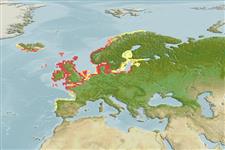Environment: milieu / climate zone / depth range / distribution range
Ecología
marino; salobre demersal; oceanodromo (Ref. 51243); rango de profundidad 6 - 30 m (Ref. 57178). Temperate; 80°N - 37°N, 25°W - 36°E
Northeast Atlantic: Murman and Spitzbergen to Portugal, including Iceland and much of the Baltic.
Length at first maturity / Tamaño / Peso / Age
Maturity: Lm 13.0, range 11 - 15 cm
Max length : 40.0 cm SL macho / no sexado; (Ref. 4674); common length : 20.0 cm TL macho / no sexado; (Ref. 4645)
Short description
Morfología | Morfometría
Tip of pectoral fin reaches the front end of the dorsal fin. Dark spot on each side of the snout. Two pointed teeth in the palate. Upper jaw not protractile (Ref. 35388).
Inshore, including the inter-tidal zone and estuaries, and offshore to about 60 m depth. Commonly associated with Ammodytes species. Feeds initially on zooplankton, later small fish (clupeids and ammodytids) dominate the diet. Summer batch spawner. Used mainly for fishmeal and oil, but also utilized fresh and pan-fried for human consumption (Ref. 9988).
Muus, B.J. and P. Dahlström, 1974. Collins guide to the sea fishes of Britain and North-Western Europe. Collins, London, UK. 244 p. (Ref. 173)
IUCN Red List Status (Ref. 130435)
Threat to humans
Harmless
Human uses
Pesquerías: muy comercial; carnada: occasionally
Más información
ReferenciasAcuiculturaPerfil de acuiculturaRazasGenéticaElectrophoresesheritabilidadEnfermedadesProcesamientoNutrientsMass conversion
Herramientas
Special reports
Download XML
Fuentes de Internet
Estimates based on models
Preferred temperature (Ref.
123201): 8.8 - 12.8, mean 10.3 °C (based on 476 cells).
Phylogenetic diversity index (Ref.
82804): PD
50 = 0.7500 [Uniqueness, from 0.5 = low to 2.0 = high].
Bayesian length-weight: a=0.00269 (0.00152 - 0.00475), b=3.01 (2.85 - 3.17), in cm total length, based on LWR estimates for this species & (Sub)family-body (Ref.
93245).
Nivel trófico (Ref.
69278): 4.0 ±0.1 se; based on diet studies.
Generation time: 2.7 ( na - na) years. Estimated as median ln(3)/K based on 1
growth studies.
Resiliencia (Ref.
120179): Medio, población duplicada en un tiempo mínimo de 1.4-4.4 años (tm=2; Fec=35,000).
Fishing Vulnerability (Ref.
59153): Low to moderate vulnerability (32 of 100).
Nutrients (Ref.
124155): Calcium = 50.7 [28.6, 103.2] mg/100g; Iron = 0.402 [0.237, 0.669] mg/100g; Protein = 18.9 [17.2, 20.8] %; Omega3 = 0.405 [0.217, 0.718] g/100g; Selenium = 10.1 [4.9, 20.7] μg/100g; VitaminA = 20.1 [7.0, 60.0] μg/100g; Zinc = 0.594 [0.420, 0.824] mg/100g (wet weight);
